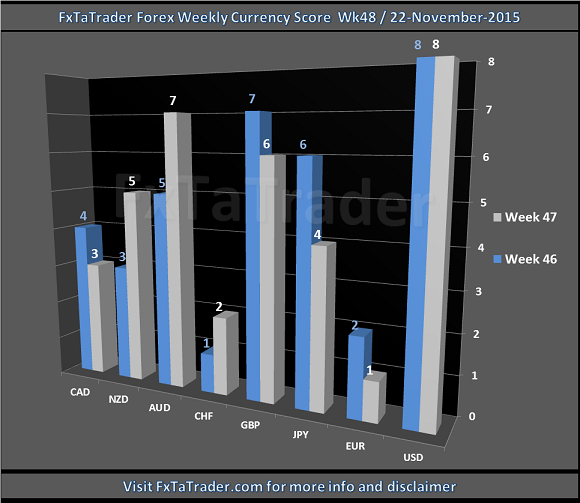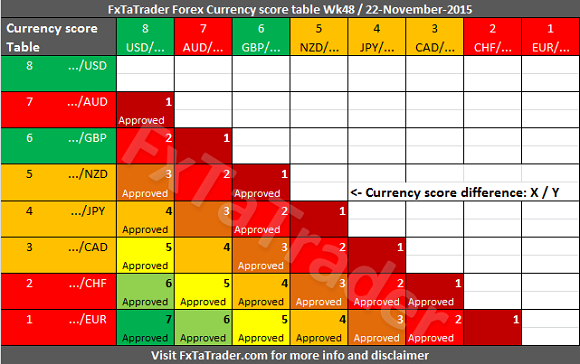0
165
The
Currency Score analysis is one of the parameters used for the
Ranking and Rating list which was published earlier this weekend.
Besides this analysis and the corresponding chart I also provide the
Forex ranking and rating list.
It is recommended to read the page Currency score explained and Models in practice for a better understanding of the article. This article will provide my analysis on the 8 major currencies based on the technical analysis charts using the MACD and Ichimoku indicator on 4 time frames: the monthly, weekly, daily and 4 hours. The result of the technical analysis is the 2 screenshots in this article showing the Currency Score and the Currency Score Difference.
According to the Ranking and Rating list already published this weekend the following pair combinations look interesting:
A. -> SA = Strong Average
B. -> SW = Strong Weak
C. -> AW = Average Weak
Strong currencies
According to the Ranking and Rating list already published this weekend
the following pair combinations look interesting:
The technical analysis is the most important issue to consider
before taking positions. The Weekly Chart is analyzed. I prefer
the Bollinger Band for defining where a pair is in the chart. Once a
pair is outside a Bollinger Band it is in a strong trend which can
cause a strong pullback. Although this may be a good opportunity for
other analysts I avoid taking positions because of the possible
unexpected strong pullback. Positions are only opened inside the
Bollinger Band and this may be at the start of a possible trend or on a
good pullback in an existing trend.
DISCLAIMER: The
articles are my personal opinion, not recommendations, FX trading is
risky and not suitable for everyone.The content is for educational
purposes only and is aimed solely for the use by ‘experienced’ traders
in the FOREX market as the contents are intended to be understood by
professional users who are fully aware of the inherent risks in forex
trading. The content is for 'Forex Trading Journal' purpose only.
Nothing should be construed as recommendation to purchase any financial
instruments. The choice and risk is always yours. Thank you.
It is recommended to read the page Currency score explained and Models in practice for a better understanding of the article. This article will provide my analysis on the 8 major currencies based on the technical analysis charts using the MACD and Ichimoku indicator on 4 time frames: the monthly, weekly, daily and 4 hours. The result of the technical analysis is the 2 screenshots in this article showing the Currency Score and the Currency Score Difference.
______________________________________
Last 3 months currency classification
The last 3 months currency classifications from a longer term perspective are provided for reference purposes. The necessary charts can be found in the previous article Weekly Currency Score Wk47. The currencies are classified for the coming weeks as follows:- Strong: GBP / USD. The preferred range is from 7 to 8.
- Average: CAD / NZD / JPY. The preferred range is from 4 to 6.
- Weak: AUD / CHF / EUR. The preferred range is from
1 to 3.
______________________________________
Currency Score
For analyzing the best pairs to trade the last 3 months currency classification is the first issue. When looking at the most recent score that is used for the coming period we can see in the screenshot below the deviations and we can come to certain conclusions. These are explained below the screenshot.
______________________________________
In essence it boils down to the 3 following lines of text:
- A strong currency can be traded long against all the other currencies except on a pullback(deviation) then it seems best to trade it only against a weak currency.
- A weak currency can be traded short against all the other currencies except on a pullback(deviation) then it seems best to trade it only against a strong currency.
- When an average currency is outside the range(deviation) it is best not to trade it against it's own currencies in the average range and the currencies in the range it is at.
According to the Ranking and Rating list already published this weekend the following pair combinations look interesting:
- EUR/USD with the GBP/CAD
- USD/CHF with the EUR/GBP
- GBP/CHF with the USD/CAD
A. -> SA = Strong Average
B. -> SW = Strong Weak
C. -> AW = Average Weak
Strong currencies
- There is a deviation for the GBP with a score of 6. This is a strong currency and it should have by preference a score from 7 to 8.
- There is most probably a pullback for the GBP when looking at the market as a whole, the uptrend has lost momentum.
- B. The GBP has a score at the moment of an average currency and it seems best for trading going long against the weak currencies (SW). The pairs selected from the Ranking and Rating list are the EUR/GBP and the GBP/CHF.
- There are no other deviations meaning that the other strong currency (USD) seem best for trading, depending on the opportunities coming around, in the following ways:
- A. going long against the average currencies (SA). The pair selected from the Ranking and Rating list is the USD/CAD.
- B. going long against the weak currencies (SW). The pairs selected from the Ranking and Rating list are the EUR/USD and the USD/CHF.
- There is a deviation for the CAD with a score of 3. This is an average currency and it should have by preference a score from 4 to 6.
- There is a decrease of momentum for the CAD which is getting weaker.
- A. The CAD has a score at the moment of a weak currency and it seems best for trading going short against the strong currencies (SA). The pairs selected from the Ranking and Rating list are the USD/CAD and the GBP/CAD.
- There are no other deviations meaning that the other average currencies (NZD and JPY) seem best for trading, depending on the opportunities coming around, in the following ways:
- A. going short against the strong currencies (SA). There are no pairs selected from the Ranking and Rating list.
- C. going long against the weak currencies (AW). There are no pairs selected from the Ranking and Rating list.
- There is a deviation for the AUD with a score of 7. This is a weak currency and it should have by preference a score from 1 to 3.
- There is most probably a pullback for the AUD when looking at the market as a whole, the downtrend has lost momentum.
- B. The AUD has a score at the moment of a strong currency and it seems best for trading going short against the strong currencies (SW). The are no pairs in the Ranking and Rating list.
- There are no other deviations meaning that the other weak currencies (CHF and EUR) seem best for trading, depending on the opportunities coming around, in the following ways:
- B. going short against the strong currencies (SW). The pairs selected from the Ranking and Rating list are the USD/CHF, EUR/USD, GBP/CHF and the EUR/GBP.
- C. going short against the average currencies (AW). There are no pairs selected from the Ranking and Rating list.
- The weak currencies against the CAD are most probably ranging and there are most probably no opportunities in the Top 10 of this week "Ranking and Rating list".
- The AUD and the GBP may offer a good opportunity to step in. However, it is important to determine if a specific pair indeed is in a pullback. For that reason it is good to see the momentum returning in that pair, check the "Ranking and Rating list". If there is momentum then also check the"Currency score difference" table.
- All the other pairs may be in a trend when complying to the "Currency score difference" table which can be seen here below. There are most probably opportunities in the Top 10 of this week "Ranking and Rating list".
- All the pairs from the Ranking and Rating list that fit well in one of the groups above
- By using the (1)"Ranking and Rating list" with the (2)above Weekly Currency Score analysis and the (3)"Currency score difference" table with the (4)Bollinger Band analysis provided here below a good foundation is provided for looking at the Weekly and Daily Technical analysis chart of a specific pair.
- The analyses are complementary where:
- the "Ranking and Rating list" takes strength, direction and volatility into account.
- the "Currency score" looks for the strong trends and pullbacks with a possible disadvantage of being overbought/oversold.
- the "Currency score difference" adds granularity to the "Currency score" by using the score difference for determining potential trends.
- the "Bollinger Band" confirms that a potential trend found is not being overbought/oversold.
- With the "Currency score difference" and the "Bollinger Band" the disadvantage mentioned for the Currency score will be overcome.
______________________________________
Currency
Score difference
- EUR/USD with the GBP/CAD
- USD/CHF with the EUR/GBP
- GBP/CHF with the USD/CAD

______________________________________
- The EUR/USD is in a downtrend and at the Bollinger Band.
- The GBP/CAD is in an uptrend and within the Bollinger Band.
- The USD/CHF is in an uptrend and just ourside the Bollinger Band. Most probably it will be inside when trading starts again.
- The EUR/GBP is in a downtrend and within the Bollinger Band.
- The GBP/CHF is in an uptrend and at the Bollinger Band.
- The USD/CAD is in an uptrend and within the Bollinger Band.
______________________________________


